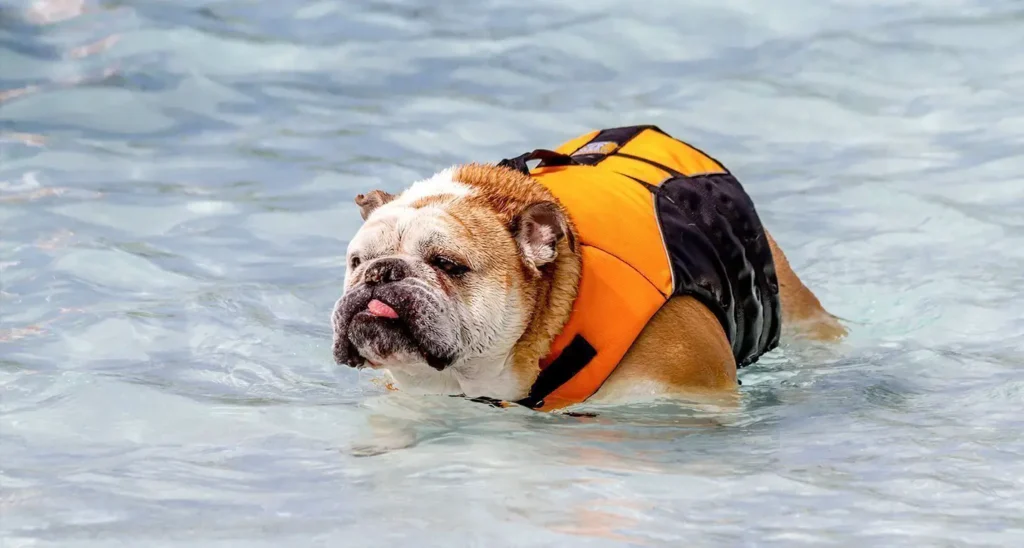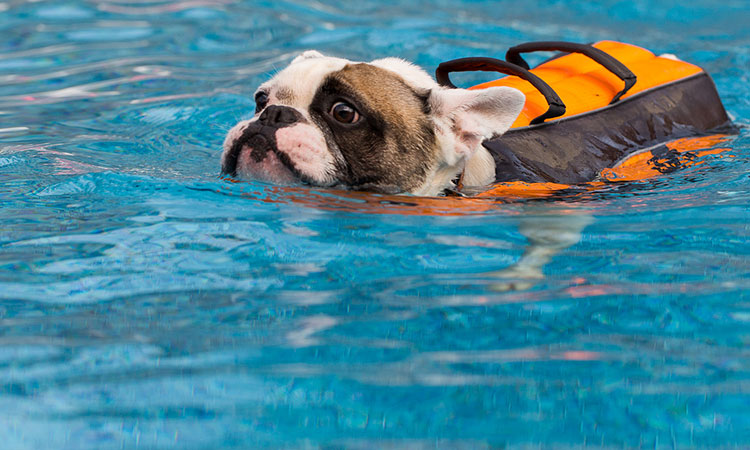Can Bulldogs Swim? Most Bulldogs can swim, but not very well. They have a flattened tail that helps them move through the water, but their bodies are not designed for swimming. Bulldogs are able to spend long periods of time submerged in water, but they are not good swimmers.
Table of Contents
The fact that bulldogs have a narrow nasal passage isn’t the only factor contributing to their poor swimming ability. In addition, there are a few things you should be aware of before letting your Bulldog swim in the pool.
We investigate each and every aspect of a Bulldog’s physique that indicate that they are poor swimmers.
Bulldogs, in contrast to Poodles and Spanish Water Dogs, were not developed to be retrieving dogs in the water. Forget about bringing them back; they have a hard enough time swimming as it is. Instead, bulldogs were developed specifically for the purpose of participating in bull-baiting, which is a form of criminal bloodsport.
3 Reasons Why Bulldogs Aren’t Good Swimmers

The Bulldog is not one of the many non-water dog breeds that are known for their exceptional swimming abilities; however, there are many such breeds. So why is it that, in comparison to other breeds of dogs, Bulldogs have a harder time participating in this kind of common physical activity?
Having a Short Nose and a Narrow Nasal Passage
We are not just speaking to traditional English Bulldogs when we state that bulldogs are unable to swim; this is true of all bulldog breeds. It’s a well-known fact that dogs of the bulldog breed aren’t known for their swimming prowess.
These bulldog kinds include the French Bulldog, Pug, Olde English Bulldogge, and pretty much any other dog breed that has a short snout, wide skull, and “smushed” face. Other bulldog types include the American Bulldog and the English Bulldog. These types of canines are referred to as brachycephalic dogs within the canine community.
These brachycephalic breeds are predisposed to a wide range of health problems, the majority of which are brought on by their congenitally shortened nasal passages. For instance, Dr. Rowena Packer, who is a DVM, asserts that this facial structure, which inhibits airflow and can make it difficult to breathe in some situations.
In light of the foregoing, the primary reason why Bulldogs shouldn’t swim is due to the condition known as brachycephaly. In order for these Bulldogs to receive an adequate amount of oxygen while swimming, they will need to raise the backs of their heads above the surface of the water.
You can probably assume that it is significantly more challenging to maintain one’s composure when doing this. Because of this significant disadvantage in the water, bulldogs are at a high risk of drowning in the absence of appropriate supervision or equipment. Simply put, so many different things may go wrong in such a little amount of time.
Compact, Muscular Dogs
If you’ve ever seen a Bulldog, you already know that they aren’t the most agile of all the different kinds of dogs. However, they are more commonly portrayed as stocky and muscular dogs with short legs, which is an accurate representation of the breed. To put it another way, bulldogs were not designed to be strong swimmers due to their body structure.
They are reportedly naturally muscular dogs, as stated by Cuteness. They are also more likely to sink than float due to the significantly higher density of muscle compared to fat. Saturated oils, of which fat is composed, have a greater propensity to rise to the surface of water. In addition to this, it has a lower density than water.
Now, let me clarify that I do not mean that your Bulldog will immediately go to the pool’s bottom. However, due to the fact that they have muscular builds, it will be considerably more difficult for them to remain afloat.
When our Bulldog was a young puppy, we took him swimming in a nearby lake for the first time. Now he’s a large, meaty dog. He was so eager to see the lake that he sprinted down the pier, but he ended up falling through like a rock.
The fact that Bulldogs can carry approximately 50 pounds on a frame that is only 14 inches tall indicates that they are likely compact and muscular. Obviously, not all Bulldogs will have the same experience with this. After all, these dogs have a high propensity for putting on extra weight and becoming obese.
Consider the following scenario: you have a piece of rock and a piece of wood that both weigh the same amount. Cast them both into the water and see what happens. Which one is more likely to sink, and how much faster will it do so? The dense granite is almost certainly to blame. If one is not careful, a Bulldog can go down in exactly the same way.
The Bulldog’s Legs Are Too Short
It is important to keep in mind that not all canines that have short legs are poor swimmers. For instance, some Corgis, which are well-known for having short, stumpy legs, are also pretty good swimmers. They can move quickly through the water thanks to the tremendous force that is stored in their thighs.
To make matters worse, the Bulldog also suffers from dwarfism, which, when added to all of the other physical challenges it faces, makes it significantly more challenging for the breed to swim.
According to the website I Heart Dogs, contrary to what the general public believes, the Bulldog is in fact a legitimate dwarf breed, just like the Welsh Corgi or the Dachshund. Despite the fact that they are considered to be giant dogs, they nonetheless maintain many of the features of a dwarf dog (short stature).
A dog breed is said to be of the dwarf variety if it has legs that are excessively short in comparison to the rest of the body (or to standard dogs). When it comes to a Bulldog-type, it is a little bit more difficult to detect, but if you were to meet one in person, you would surely notice it.
When placed in water, every dog will immediately begin what is known as “dog paddling.” It’s a technique of swimming in which the dog is essentially “trotting” across the water by alternating their front and hind legs. Dogs do this in the water. You can probably guess that the fact that dwarf dogs have such tiny legs makes paddling a lot more challenging for them.
How to Teach a Bulldog to Swim
There are many ways to teach a bulldog to swim. Some simple, some more complex. Here are five ways:
- If the bulldog is already familiar with swimming in a pool or other body of water, you can simply take them there and have them swim
- Start by teaching your dog to associate water with fun. encourage your dog to wade in, play fetch in the pool, or splash around in a bowl of water
- Once your dog is familiar with the pool, begin teaching them how to swim using basic commands such as “come,” “sit,” and “stay.”
- Once your dog is proficient at swimming, introduce them to more challenging exercises such as ladder diving and backstroke
Life Jacket for Bulldogs
Before anything else, I strongly recommend that you purchase a life jacket for your Bulldog before you take it swimming or to any other training sessions. If you’ve read the article, you already know that the genetic odds are stacked against them. The odds are genetically stacked against them.
A life jack will not only make your Bulldog feel more at ease, but it will also provide you with the peace of mind that comes from knowing that your Bulldog won’t drown even if you turn your back on him for an instant. Even if you intend to maintain a constant proximity to the dog, it is beneficial to do so.
In light of the aforementioned, the Kygen Outward Hound Life Jacket is the life vest that we have found to be the most effective for use with our dogs. It is something that both of our dogs, a Corgi and an Australian Shepherd, utilise. In addition, we have not received any criticisms or concerns up to this point.
It has a “rescue handle” and is very flexible so that it may fit your Bulldog. This is in case they get carried away in the pool and something goes wrong. Even when it’s dark out, you’ll still be able to see your dog if you choose one of the brighter colour options for the collar.
Also Read: Why does my dog smell like fish? Tips from Real Dog Owner
There is a wide range of possible physical characteristics for a bulldog. However, if you have an English Bulldog, you should probably pick the largest size available. Be sure to check the size charts, as they provide the most accurate sizing information. You will want to make sure that the fit is snug and secure on your dog.

